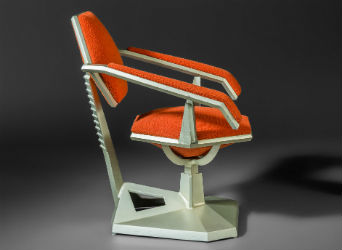
NEW YORK – On occasion, The Hot Bid revisits remarkable antique and vintage collectible that have sold. Today’s subject is a futuristic armchair designed by architect Frank Lloyd Wright.
What you see: A casual armchair, aka a sloped armchair, designed by Frank Lloyd Wright in 1956 for the Price Tower in Bartlesville, Oklahoma. Heritage Auctions estimated it at $12,000 to $18,000.
The expert: Brent Lewis, director of design at Heritage Auctions.
Could we start by telling the story of Price Tower, and how it came to be, and how it fits within the body of work of Frank Lloyd Wright? Price Tower was built in 1956. It’s a really interesting example of the work Wright was doing at the end of his life and career. [He died in 1959 at the age of 91.] He was approached by the Price family from Bartlesville, Oklahoma. Harold Price Sr. had a family business in oil and energy. Bartlesville is just outside Tulsa, a center of that [oil and energy businesses] at the time. He wanted to build a new headquarters for his company and was looking for an architect. His sons, who were taking classes in architecture, initially recommended Bruce Goff, the truly maverick architect of this period. He taught at the University of Oklahoma. He met with Price and recommended meeting with Wright instead.
What happened when the Prices met Wright? They asked him to build something three to four stories tall. He proposed a 19-story skyscraper instead, in the middle of the prairie. They were swept along with his enthusiasm for the project and it was built. Wright called it “the tree that escaped the crowded forest.”
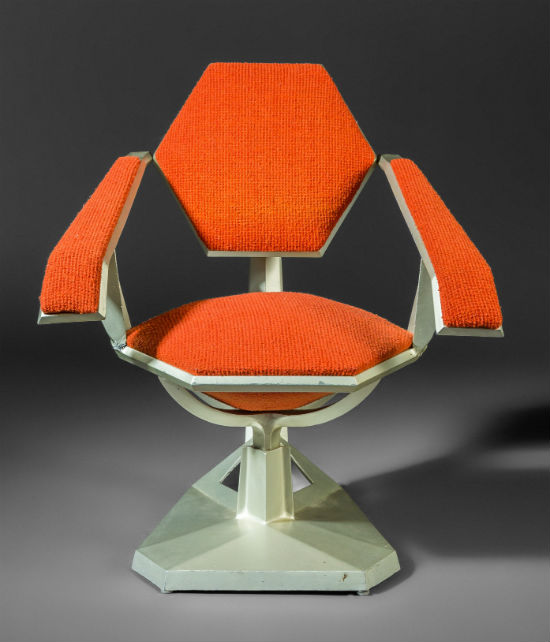
Is this the first time a Frank Lloyd Wright armchair from Price Tower has gone to auction? No. There have been a handful that have come up over the years. I count at least four of this model. About 15 years ago, an initial group of furniture from Price Tower sold in New York, and a handful have circulated and been on the market since.
Do all the Frank Lloyd Wright armchairs of this design look like this one–silver-colored frame with red upholstery? There are different variations, with different finishes and different colors of paint. We believe this one has its original paint finish. It’s been reupholstered, but in fabric that’s as close to the original as possible.
The lot notes say “some forty were originally specified.” Were 40 in fact made? I don’t know, but I suspect there were about 40 made. Some were sold and circulated over the years. The Price Tower Arts Center has many in their collection. Price Tower, the building, is now owned and operated by the nonprofit Price Tower Arts Center. It’s preserving, and in the process of preserving, more period rooms in the building, restoring them to how they were created. The funds from the sale will help them continue their core mission of preserving Price Tower.

The seat and the back of this armchair have a hexagonal shape. I also see hexagons in the back and seat of a different Frank Lloyd Wright Price Tower chair offered in the sale. Are hexagons a main design motif of the building? I wouldn’t say hexagons, as such, are specifically a formal motif Wright used, but the building is entirely about angles. It’s formed as a series of triangles locked together at 30 degrees, 60 degrees. Wright was exploring geometry in a more complex way than boxes and rectangles. The angular design is mimicked and repeated in the furniture that was designed.
So they’re not so much hexagons as joined triangles? Yeah, I would say so.
We have that great quote from Wright talking about the Price Tower, but do we have any quotes from Harold Price, Sr., or others in his family about this particular chair design? I don’t have anything at hand for you, but generally, the furniture was greeted with mixed reviews by the people who had to use it. It was designed for company offices, and the staff was meant to use the furniture. There are stories of people bringing their own chairs or desks in. The Price family must have been happy enough, because they were patrons of Frank Lloyd Wright for many years.
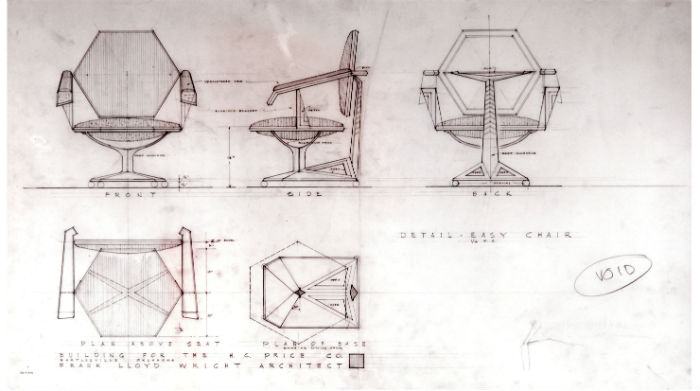
The metal spine of the Frank Lloyd Wright armchair makes me think of vertebrae. Is that deliberate? Is the back of the chair meant to imitate a spine? I think it’s an innovative use of material. Cast aluminum was not usually done at the time. Wright found a local person to do the work. He used a single material to provide the frame of the chair and provide a decorative layer to the chair at the same time. It’s one of the reasons I find the chair so compelling.
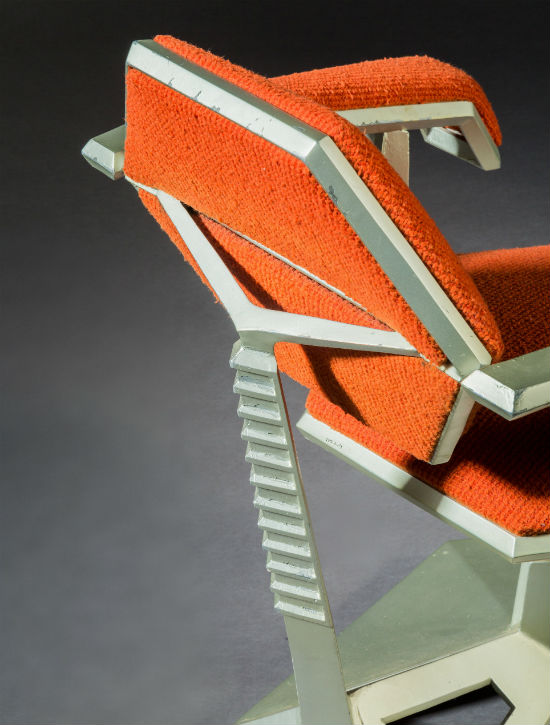
To me, it looks like the Frank Lloyd Wright armchair would have been seen as futuristic in 1956. Was the chair design considered futuristic? I don’t know how it was considered, but Price Tower was completed at a time when Wright was doing a very forward, very unique type of architecture. A couple of years later, he completed the Guggenheim in New York. His residential projects of the time were different and new. To a certain extent, people came to expect it from Wright. It was 20 years since he had done Fallingwater. He had moved quite a bit past his early and mid-career periods. At the same time, it was the mid-1950s. There were a lot of new ideas being generated through the applied arts and seen throughout the American mid-century movement. I’m not sure the degree to which it was so surprising. Also, the armchair was not made for the mass market. It was a private commission. Wright had the freedom to experiment.
This is described as a “casual armchair”. Why? What makes it casual? I think it’s probably a reference to the slope of the arms, which allows for a more casual sitting position.
Have you sat in the Frank Lloyd Wright armchair? I have.
What’s that like? It’s fine. It’s like many chairs. It felt absolutely comfortable, but I don’t know what it’s like for eight or nine hours for a workday. It feels good to sit in. I don’t know if it would win any awards for ergonomic design.
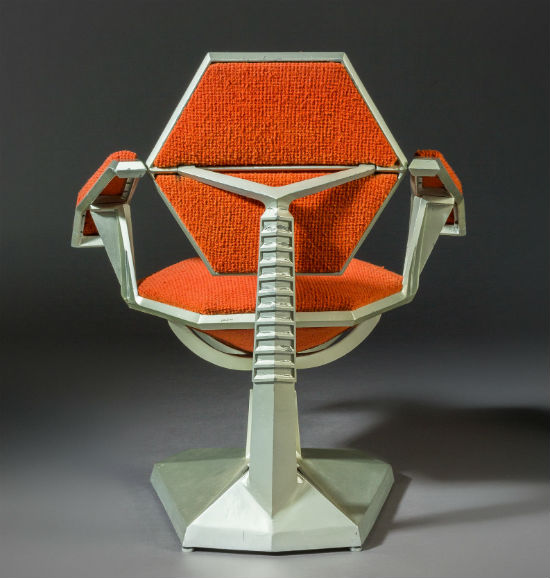
Yeah, I’ve heard tell of how … how shall I put this … Wright making designs to please himself, and perhaps not thinking much about the people who would actually have to use his designs on a daily basis. I’m not sure that’s a fair characterization. The more I learn about Wright, [I am convinced] Wright cared about what his clients felt, and he did care about the function of his designs. But the wanted to consider the whole, and the unified whole, for that matter.
What’s your favorite detail of this Frank Lloyd Wright armchair? I’d say it’s the interpretation of the pattern into the structure itself, primarily in the use of triangles. It’s an echo of the design of the building. It has very few right angles.
What’s the world auction record for this Frank Lloyd Wright armchair? I can find £48,000 (roughly $60,000) in 2007 at Christie’s South Kensington, London.
Is there any chance this example will meet or beat the one that sold at Christie’s? Is its provenance better? I think we have to wait and see. It’s a very strong market for Wright right now. This is a great example, and I hope collectors will recognize it as such. I hope we’ll get a good price for the Price Tower Arts Center.
Why will this Frank Lloyd Wright armchair stick in your memory? It has its own visual language, its own aesthetic vocabulary, that can’t be mistaken for anything else. Once you see it, you’ll remember it. In that way, it’s iconic.
__________________________________________________________
By Sheila Gibson Stoodley
Sheila Gibson Stoodley is a journalist and the author of The Hot Bid, which features intriguing lots coming up at auction. Follow her on Twitter at @SGSwritereditor.


